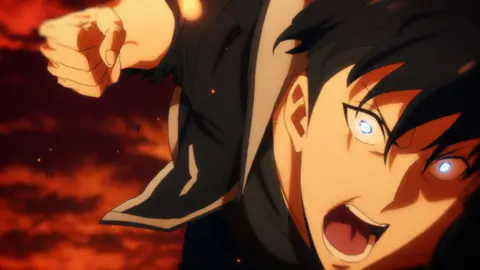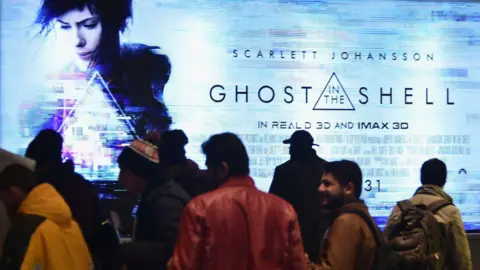BBC World Service
 Courtesy of Netflix
Courtesy of NetflixWhen Netflix announced plans for a live-action remake of a beloved anime series, it was met with doubtful and even divided fans.
Solo Leveling – which charts a lowly monster hunter’s rise to power – is a classic tale of the triumph of an underdog. Originally a hit Korean web novel from 2016, its popularity surged globally after it was made into an anime series eight years later.
Fans love it but that has only made them sceptical of a live-action adaptation.
“I have never had a great experience with live-action and I do not see a future or need for them to exist,” says Swedish fan Andre Denisson.
Anime has captured imaginations for decades now, but the art, and its fans, have always seemed beyond the reach of mainstream film studios.
Hollywood has struggled to pull off live-action remakes, and yet its successor – on-demand streaming – is keen to cash in on the genre.
Why has it proved so hard to bring anime alive on the screen?
An elusive art
Live-action remakes are a “hit or miss”, says Ander Guerrero, an anime fan based in Spain.
He is concerned that the CGI for Solo Leveling will not be able to do justice to the source material: “The anime looks incredible mainly because of the fight sequences, which could be hard to replicate in live-action.”
There are plenty of such moments in Solo Leveling, which is set in a world where mankind’s survival depends on “hunters” – humans with special abilities – battling and defeating magical monsters that appear through mysterious portals, or “gates”.
Monster hunters’ abilities are pre-determined and cannot change. When we meet the main character, Sung Jin-woo, he is mankind’s “weakest weapon” – but after a near-death experience, he becomes the only one with the ability to “level up” his abilities.
The story, and the rich sequences it portrayed, even unseated fan favourites like Demon Slayer and One Piece to become the most watched series in the history of Crunchyroll, an anime streaming site for audiences outside Asia, according to Sony, which owns the platform.
 Courtesy of Netflix
Courtesy of NetflixSo fans are unconvinced Netflix can deliver what they expect.
Those who watch the live-action remake “will not get the same experience,” insists Mr Guerrero, who expects the result to be “a half-baked story” where key plot points will be missing.
Turning anime into live action is a formidable creative challenge and a balancing act: on the one hand is a discerning fandom and on the other hand, an irresistible opportunity to find new audiences.
Casting and production aside, it is essential to get the tone right, says Geoff Thew, who reviews anime on his YouTube channel “Mother’s Basement” for nearly 1.4 million followers.
“Things that work, dramatically and aesthetically, in the heightened reality of animation don’t always translate to live action,” he says.
“The most iconic moments of the original anime might not work in live action, but whatever changes you make, those moments still need to be recognisable to fans.”
Hollywood dreams
Hollywood first adapted anime into live-action in the 1990s but it did not go well.
The 2009 adaptation of Dragonball Evolution was so ridiculed by fans of the four-decade-old iconic franchise that the scriptwriter felt compelled to publicly apologise years later.
A 2017 film inspired by Japanese manga and 1995 anime film Ghost in the Shell, starring Scarlett Johansson, was lambasted for whitewashing and bombed – its losses reportedly exceeded $60m.
Yet Hollywood is determined to try again with several big-ticket projects now under way.
Legendary, the US film production company behind movies like Dune and Jurassic World, will be making a movie of Gundam, a military science fiction anime series about a giant robot that began in 1979. Sydney Sweeney is in final negotiations to star in it, according to media reports.
Global content giant Lionsgate is reportedly developing Naruto, an anime about a young, underdog ninja who works his way up to become the village protector.
“There is almost a desire now to make the perfect live-action, to somehow figure out what the formula is,” says Emerald King, a Japanese culture expert at the University of Tasmania, Australia.
 Getty Images
Getty ImagesThe size of the market may have something to do with it.
The wider anime market, which also includes merchandising and music, was valued around $34bn in 2024, according to Grand View Research, and is projected to grow to over $60bn by 2030.
Netflix doesn’t usually release detailed viewership figures, but its latest data only appears to confirm the appetite for anime is growing.
In July it said more than half of its 300 million subscribers watch anime, and the genre was watched more than one billion times in 2024, a three-fold rise in the last five years.
Niche to mainstream
“Watching anime used to be like ‘for weirdos’ when I was younger,” says Parisa Haghighat, a 34-year-old fan from the UK.
She discovered anime like Doraemon and Sailor Moon in school when she used to spend her summer holidays in Thailand.
She still watches anime, she says, although now “it’s more common and cool, so some people that used to make fun of me now watch it themselves!”
Reviewer Geoff Thew believes the pandemic played an important role in the “seismic shift” of attitudes towards anime: “Being locked inside, people had a lot of free time and not much to do besides binge TV.”
To some, anime is “a refreshing alternative”, says Cathy Boxall, global head of entertainment at marketing agency Dentsu. “Audiences find it offers emotional complexity, genre diversity and cultural specificity.”
Fatigue with Hollywood franchises has emerged as a factor in research.
One in 10 respondents to a Dentsu study said they watched anime because they were tired of Hollywood tropes. In the US, as many as three in 10 people watch anime when they want a break from Hollywood.
So why bother with live-action adaptations, when anime itself is so appealing?
With anime available so widely, Netflix likely sees live-action remakes as a differentiator, says Alex Cameron of Parrot Analytics. Regular watchers may want to watch the original anime after streaming the live-action – and that’s longer retention and engagement, he added.
 Courtesy of Netflix
Courtesy of NetflixNetflix also appears to be learning from past mistakes.
Six years after the universally panned adaptation of Death Note, its 2023 live- action version of One Piece, featuring an international cast, won widespread praise.
While there are attempts to make live-action treatments feel more authentic, Dr King says it needs a more thoughtful approach: “You can go too far in trying to be respectful and end up exoticising it.”
The cast and crew should be “aware of the product that’s being made”, he adds.
For example, One Piece, at its heart, is a series about pirates. “It allows them to interpret the text in the spirit of the original. Without being a slave to the adaptation, it’s allowed to be free,” he says.
Will the live-action version of Solo Leveling replicate One Piece’s success?
“The overall tone of the series is comparable to a darker superhero movie. If the fights are cool and Sung Jin-woo gets a few chances to be a badass each episode, fans likely won’t complain too much,” Mr Thew says.
Fans are indeed hopeful because Solo Leveling will be led by a Korean cast and crew.
“It is a good way to maintain most of the core of the story – some of the Hollywood casting leads to the loss of small cultural or story nuances, and these are sometimes the backbone of the story, ” says Archie Moyo, a fan from Zimbabwe.
“I’m excited about the live-action because it will introduce a lot more people to the Solo Leveling world.”




